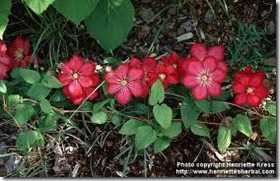Some people refer to it as Old Man’s Beard or Traveler’s Joy, however, this member of the Ranunculaceae genus is best known as clematis. Choose clematis plants from all three cultivar groups to enjoy the color of flowers from spring to fall and the visual texture of vines and seed heads throughout the year. Clematis prefers well-drained soil and insists on having its roots and bottoms in shaded, well-drained soil. The plants’ distinctive leaves and flowers flourish in sun or partial shade.
- Difficulty:
- Easy
Instructions
things you’ll need:
- Shovel
- Clematis plant
- Organic matter
- Bamboo split
- Lattice panel or twine
- Water source
- Dig the planting hole 5 inches or less from the fence where you want to grow the clematis. The size should be approximately 18 inches wide and deep, according to horticulturists at the University of Michigan. A chain-link fence will offer the best air flow. If you have a solid wooden fence, provide a piece of wooden lattice, a trellis or lines of twine between the plant and fence for the small tendrils of growing vine to attach as it grows taller and wider.
- Remove the clematis plant from original pot and place in the hole to test for correct depth. The crown — where the soil meets the base of the stem — should sit approximately 6 inches below ground level. The new vines emerge from the root ball under the soil, and this depth provides that rich, subterranean birth environment for new shoots.
- Back-fill the planting hole around the plant’s base. The original displaced soil should be mixed with rich, organic matter such as humus, well-decomposed compost or peat moss prior to back-fill. Replaced soil should be level with surrounding ground.
- Tamp soil lightly with the back of shovel or with your foot to remove air pockets and secure the clematis into position. Water the plant into the new space thoroughly until the ground is saturated, yet drains easily without leaving standing puddles.
- Attach a bamboo split, thin piece of cane or comparable stick from the base of the existing shoots to the fence. The stick acts as a ramp to steady the new shoots across the gap between the plant and the fence or lattice. If the shoots are long enough at planting, gently thread them around the coils of a chain link fence or lattice attached to a wooden fence.


Deprecated: strpos(): Passing null to parameter #1 ($haystack) of type string is deprecated in /home/agriviek8Qv/agriviet.net/public_html/wp-includes/comment-template.php on line 2522